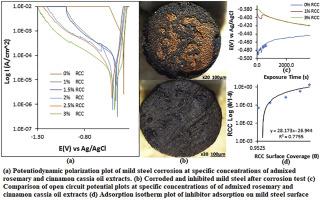Sustainable Chemistry and Pharmacy ( IF 5.5 ) Pub Date : 2020-08-07 , DOI: 10.1016/j.scp.2020.100298 Roland Tolulope Loto

|
The corrosion resistance of mild steel (MS) in 0.5 M H2SO4 and HCl solution with specific concentrations of the intermixture of rosemary and cinanamon cassia essential oil extracts (RCC) was studied by potentiodynamic polarization method, open circuit potential analysis (OCP) and optical macroscopy. Information obtained showed RCC effectively inhibited MS corrosion from the lowest to the highest concentrations in both acids with lowest inhibition result of 95.30% and 94.19%, and highest inhibition efficiency of 99.21% and 97.69%. RCC exhibited dominant cathodic inhibition effect in H2SO4 due to suppression of the reduction reactions while in HCl RCC displayed mixed inhibition properties due to surface coverage effect in the presence of Cl− anions. OCP showed RCC increased the thermodynamic tendency of MS to corrosion in H2SO4 solution despite effective inhibition performance with significant electronegative shift in corrosion potential. In HCl significant electropositive potential displacement was observed relative to the potential of the control MS due to adsorbed protonated RCC molecules unto the steel. Adsorption of RCC molecules on MS aligned with Langmuir, Frumkin and Freundlich isotherm models through chemisorption mechanism in both acids with average correlation coefficient value above 0.9. Optical images of MS in both acids without RCC showed severe surface degradation with the degree of degradation being higher from H2SO4 solution. Optical images from RCC inhibited steel depict effective surface protection.
中文翻译:

迷迭香和肉桂肉桂油的混合物对弱酸性电解液中低碳钢的缓蚀作用评估
通过电势极化法,开路电势分析(OCP)和电势极化法研究了0.5 MH 2 SO 4和HCl溶液中特定浓度的迷迭香和肉桂肉桂精油提取物(RCC)的低碳钢(MS)的耐腐蚀性。光学宏观检查。获得的信息表明,RCC在两种酸中均能从最低浓度到最高浓度有效抑制MS腐蚀,抑制效果最低,分别为95.30%和94.19%,最高抑制效率为99.21%和97.69%。RCC在H 2 SO 4中表现出显着的阴极抑制作用由于同时在HCl RCC还原反应的抑制显示由于在氯的存在下表面覆盖效果混合抑制性质-阴离子。OCP显示RCC增加了MS在H 2 SO 4中腐蚀的热力学趋势尽管具有有效的抑制性能,但溶液的腐蚀电位却显着负电迁移。在HCl中,由于吸附到钢上的质子化RCC分子,相对于对照MS的电势,观察到明显的正电势位移。RCC分子在两种酸中的化学吸附机理均与Langmuir,Frumkin和Freundlich等温线模型相吻合,其平均相关系数值均高于0.9。在两种无RCC的酸中,MS的光学图像均显示出严重的表面降解,其中H 2 SO 4溶液的降解程度更高。来自RCC抑制钢的光学图像描述了有效的表面保护。











































 京公网安备 11010802027423号
京公网安备 11010802027423号